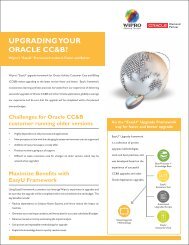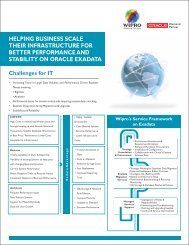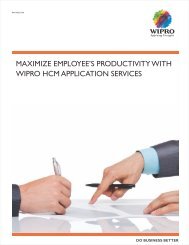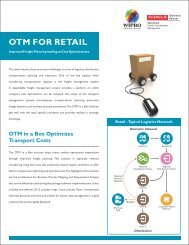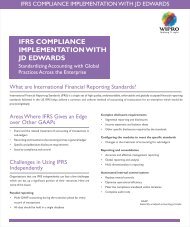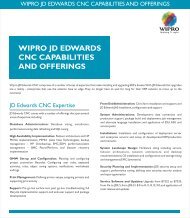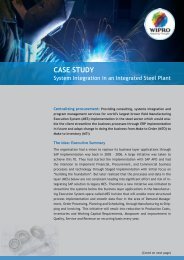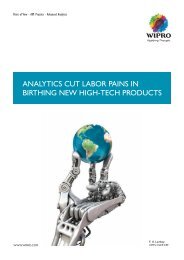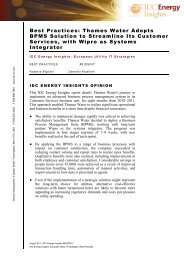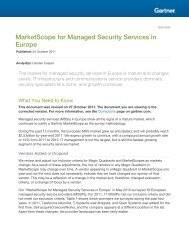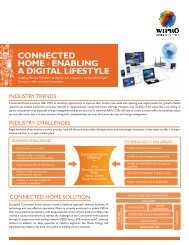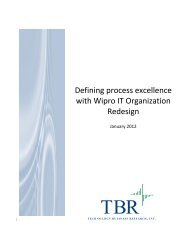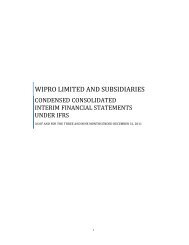Using CMM with DO-178B/ED-12B for Airborne System Development
Using CMM with DO-178B/ED-12B for Airborne System Development
Using CMM with DO-178B/ED-12B for Airborne System Development
You also want an ePaper? Increase the reach of your titles
YUMPU automatically turns print PDFs into web optimized ePapers that Google loves.
Wipro Technologies<br />
Innovative Solutions, Quality Leadership<br />
<strong>Using</strong> <strong>CMM</strong> <strong>with</strong> <strong>DO</strong>-<strong>178B</strong>/<strong>ED</strong>-<strong>12B</strong><br />
<strong>for</strong> <strong>Airborne</strong> <strong>System</strong> <strong>Development</strong><br />
WHITE PAPER<br />
Author : Narasimha Swamy (Project Manager, Avionics Practice)<br />
Most aircraft companies develop onboard systems software <strong>for</strong> civilian aircraft based on the<br />
guidelines RTCA <strong>DO</strong>-<strong>178B</strong>/<strong>ED</strong>-<strong>12B</strong> "Software Considerations in <strong>Airborne</strong> <strong>System</strong>s and<br />
Equipment Certification". This, apart from ensuring the reliability of the software, also addresses<br />
the issues involved in certification of the onboard system. SEI-<strong>CMM</strong> is used to<br />
measure organization's capability in software development and also improvement. As the<br />
costs and timelines become stringent, it becomes necessary <strong>for</strong> companies to improve their<br />
software development process by adopting SEI-<strong>CMM</strong> to make sure that the software is<br />
developed as per plan and there is involvement of the higher management in the development<br />
process.<br />
This paper looks at these two standards <strong>with</strong> a view to implement <strong>DO</strong>-<strong>178B</strong> in organizations<br />
which are SEI-<strong>CMM</strong> level 5 certified and vice versa. Implementing <strong>DO</strong>-<strong>178B</strong> <strong>with</strong>in SEI-<strong>CMM</strong> is<br />
required only if the company is involved in development of safety critical softwares.<br />
Keywords:<br />
SEI-<strong>CMM</strong>, SW-<strong>CMM</strong>I, RTCA <strong>DO</strong>-<strong>178B</strong>, RTCA <strong>DO</strong>-2488B, FAA, Process, Software <strong>Development</strong>
White Paper<br />
<strong>Using</strong> <strong>CMM</strong> <strong>with</strong> <strong>DO</strong>-<strong>178B</strong>/<strong>ED</strong>-<strong>12B</strong> <strong>for</strong> <strong>Airborne</strong> <strong>System</strong> <strong>Development</strong><br />
Table of Contents<br />
Introduction ........................................................................................................... 3<br />
Overview of SEI-<strong>CMM</strong> ........................................................................................... 3<br />
Mature Organization ................................................................................................... 4<br />
Levels of Maturity ........................................................................................................ 4<br />
Key Process Areas (KPAs) ......................................................................................... 6<br />
Advantages of using <strong>CMM</strong> ......................................................................................... 6<br />
Overview of RTCA <strong>DO</strong>-<strong>178B</strong> ................................................................................. 6<br />
Software Levels .......................................................................................................... 6<br />
Life Cycle .................................................................................................................... 7<br />
Certification Issues .................................................................................................... 7<br />
Advantages of <strong>DO</strong>-<strong>178B</strong>: ............................................................................................ 7<br />
Comparison of SEI-<strong>CMM</strong> and <strong>DO</strong>-<strong>178B</strong> ............................................................................... 7<br />
Conclusion ............................................................................................................................ 8<br />
References ........................................................................................................................... 9<br />
About Wipro Technologies ................................................................................................... 9<br />
Wipro in Embedded Technologies .................................................................................... 10<br />
Page : 2 of 10
White Paper<br />
<strong>Using</strong> <strong>CMM</strong> <strong>with</strong> <strong>DO</strong>-<strong>178B</strong>/<strong>ED</strong>-<strong>12B</strong> <strong>for</strong> <strong>Airborne</strong> <strong>System</strong> <strong>Development</strong><br />
Introduction<br />
There have been a number of standards/guidelines used in the development of software<br />
<strong>for</strong> various purposes. They have evolved over a period of time as <strong>with</strong> the evolution of the<br />
software industry. Different industries require different standards/guidelines based on its<br />
necessity. Even though these standards/guidelines have some similarity, they also have<br />
typical uniqueness that distinguishes them from others. This white paper studies two<br />
such standards used in software development - the <strong>DO</strong>-<strong>178B</strong> and SEI-<strong>CMM</strong>. A comparison<br />
is made between the two standards and the differences are highlighted.<br />
RTCA <strong>DO</strong>-<strong>178B</strong> sets the guidelines <strong>for</strong> the development of software <strong>for</strong> onboard systems.<br />
It has been used generally by civilian aircraft industries. It also finds usage in other safety<br />
critical applications like nuclear power plant, space and missile technologies. It is<br />
necessary that <strong>DO</strong>-<strong>178B</strong> guidelines are used <strong>for</strong> the development of software <strong>for</strong> any on<br />
board system to facilitate certification.<br />
SEI-<strong>CMM</strong> is used to measure/indicate organization's process capability in software<br />
development and also its improvement. It is a general standard and has been used by<br />
many organizations worldwide in software development. Usage of it has improved the<br />
software development process and also made such organizations trust worthy. <strong>CMM</strong><br />
aims at improving the product quality by improving the processes used in product<br />
development.<br />
As organizations grow in size, it becomes necessary to have a tighter control over project<br />
execution, maintaining the schedule & ef<strong>for</strong>t and at the same time keeping the quality of<br />
the product high. This implies that there should be means of control/involvement from the<br />
top management to make sure that the project goals are met. It also implies that there<br />
should be scope <strong>for</strong> innovation and improvement in process based on past experience.<br />
This is the reason why <strong>CMM</strong> was introduced and which has been adopted by many<br />
organizations worldwide. <strong>DO</strong>-<strong>178B</strong> specifically does not allow this kind of management<br />
and innovation and hence restricting itself to only product development. This argument<br />
proves that, when dealing <strong>with</strong> the development of safety critical systems <strong>for</strong> onboard use,<br />
we need <strong>DO</strong>-<strong>178B</strong>, which concentrates on product, and at the same time from an organization<br />
point of view we need <strong>CMM</strong> or any of its kind of standard to be adopted.<br />
Organizations that are executing projects in the aerospace domain or developing systems<br />
that are safety critical will have to build their development process such that they combine<br />
both <strong>CMM</strong> and <strong>DO</strong>-<strong>178B</strong> or similar standard. That kind of a process will have dual goal of<br />
organizational control/involvement and at the same time meeting the quality requirements<br />
of the standard being followed.<br />
As organizations decide to have both <strong>DO</strong>-<strong>178B</strong> based product development as well as<br />
<strong>CMM</strong> based Project Management, it becomes necessary <strong>for</strong> them to understand both<br />
these standards and also find the differences that exist need to be handled. This will be<br />
the first step in adoption of both the standards. The following paragraphs explain both<br />
<strong>CMM</strong> and <strong>DO</strong>-<strong>178B</strong> briefly and then state where and how they differ.<br />
Overview of SEI-<strong>CMM</strong><br />
The process maturity framework was first developed in September 1987 by Software<br />
Engineering Institute (SEI) of Carnegie Mellon University <strong>with</strong> the assistance of Mitre<br />
Corporation. After 4 years of experience <strong>with</strong> software process maturity framework, the SEI<br />
evolved the maturity framework into Capability Maturity Model (<strong>CMM</strong>) <strong>for</strong> software.<br />
Page : 3 of 10
White Paper<br />
<strong>Using</strong> <strong>CMM</strong> <strong>with</strong> <strong>DO</strong>-<strong>178B</strong>/<strong>ED</strong>-<strong>12B</strong> <strong>for</strong> <strong>Airborne</strong> <strong>System</strong> <strong>Development</strong><br />
The Capability Maturity Model provides software development organizations <strong>with</strong> guidance<br />
on how to gain control of their processes <strong>for</strong> developing and maintaining software and<br />
evolving a culture of software engineering and management excellence.<br />
Mature Organization<br />
A mature software organization possesses an organization-wide ability <strong>for</strong> managing<br />
software development and maintenance processes. The software process is accurately<br />
communicated to all the employees and work activities are carried out according to the<br />
planned process. The processes mandated are usable and consistent <strong>with</strong> the way the<br />
work actually gets done. These defined processes are updated when necessary and<br />
improvements are made through controlled pilot-tests and/or cost benefit analysis. Roles<br />
and responsibilities <strong>with</strong>in the defined process are clear throughout the project and<br />
across the organization.<br />
In a mature organization, managers monitor the quality of the software products and the<br />
process that produce them. There is an objective, quantitative basis <strong>for</strong> judging product<br />
quality and analyzing problems <strong>with</strong> the product and process. Schedules and budgets are<br />
based on historical per<strong>for</strong>mance and are realistic; the expected results <strong>for</strong> cost, schedule,<br />
functionality, and quality of the product are usually achieved. In general, a disciplined<br />
process is consistently followed because all of the participants understand the value of<br />
doing so, and the necessary infrastructure exists to support the process.<br />
Levels of Maturity<br />
The <strong>CMM</strong> suggests five levels of maturity of the company process. The maturity level of a<br />
company indicates the effectiveness of company's software development practices.<br />
Maturity level 1 is the lowest one and at this level, the practices of the company are vague<br />
and does not provide stable environment <strong>for</strong> developing and maintaining the software.<br />
Maturity level 5 is the highest and at this level the company is said to be at the optimizing<br />
level and has practices to develop and maintain software efficiently. The five levels are<br />
briefly described below and is pictorially represented in Fig 1.<br />
Level 1: Initial Level<br />
At this level, the organization does not have any defined process and the development<br />
activities are chaotic. The success and repeatability depends on the individual/team but<br />
there is no structured help from the organization.<br />
Level 2: Repeatable Level<br />
At the Repeatable Level, policies <strong>for</strong> managing a software project and procedures to<br />
implement those policies are established. Planning and managing new projects is<br />
based on experience <strong>with</strong> similar projects. Process capability is enhanced by establishing<br />
basic process management discipline on a project by project basis. An effective<br />
process can be characterized as one which is practiced, documented, en<strong>for</strong>ced, trained,<br />
measured, and able to improve.<br />
Level 3: Defined Level<br />
At the Defined Level, the standard process <strong>for</strong> developing and maintaining software<br />
across the organization is documented, including both software engineering and<br />
management processes, and these processes are integrated into a coherent whole.<br />
This standard process is referred to throughout the <strong>CMM</strong> as the organization's standard<br />
software process. Processes established at Level 3 are used (and changed, as<br />
appropriate) to help the software managers and technical staff per<strong>for</strong>m more effectively.<br />
Page : 4 of 10
White Paper<br />
<strong>Using</strong> <strong>CMM</strong> <strong>with</strong> <strong>DO</strong>-<strong>178B</strong>/<strong>ED</strong>-<strong>12B</strong> <strong>for</strong> <strong>Airborne</strong> <strong>System</strong> <strong>Development</strong><br />
Level 4: Managed Level<br />
At the Managed Level, the organization sets quantitative quality goals <strong>for</strong> both software<br />
products and processes. Productivity and quality are measured <strong>for</strong> important software<br />
process activities across all projects as part of an organizational measurement program.<br />
An organization-wide software process database is used to collect and analyze the data<br />
available from the projects' defined software processes. Software processes are<br />
instrumented <strong>with</strong> well-defined and consistent measurements at Level 4. These measurements<br />
establish the quantitative foundation <strong>for</strong> evaluating the projects' software<br />
processes and products.<br />
Level 5: Optimizing<br />
At the Optimizing Level, the entire organization is focused on continuous process<br />
improvement. The organization has the means to identify weaknesses and strengthen<br />
the process proactively, <strong>with</strong> the goal of preventing the occurrence of defects. Data on the<br />
effectiveness of the software process is used to per<strong>for</strong>m cost benefit analyses of new<br />
technologies and proposed changes to the organization's software process. Innovations<br />
that exploit the best software engineering practices are identified and transferred<br />
throughout the organization.<br />
Defined (3)<br />
Optimizing (5)<br />
Process chainge management<br />
Technology change management<br />
Defect prevention<br />
Managed (4)<br />
Software quality management<br />
quantitative process management<br />
Peer reviews<br />
Intergroup coordination<br />
Software product engineering<br />
intergrated software management<br />
Training program<br />
Organization Process definition<br />
Organization process focus<br />
Repeatable (4)<br />
Software configuration management<br />
Software Quality assuance<br />
Software subcontract management<br />
software project tracking and oversight<br />
software project planinig<br />
Requirements mangement<br />
Initial (1)<br />
Figure 1 : Key process Area by maturity Level<br />
Page : 5 of 10
White Paper<br />
<strong>Using</strong> <strong>CMM</strong> <strong>with</strong> <strong>DO</strong>-<strong>178B</strong>/<strong>ED</strong>-<strong>12B</strong> <strong>for</strong> <strong>Airborne</strong> <strong>System</strong> <strong>Development</strong><br />
Key Process Areas (KPAs)<br />
As seen in Figure 1, each level is associated <strong>with</strong> certain Key Process Areas, also called<br />
as KPAs. The KPAs at each level give the desirable practices that are required by the<br />
software development process. The organization's maturity level is based on the KPAs<br />
that it completely practices till that level. So, if a company is certified at Level 4, it indicates<br />
that all KPAs of Level 2 and Level 3 are also met along <strong>with</strong> the KPAs of Level 4.<br />
Advantages of using <strong>CMM</strong><br />
By properly implementing the <strong>CMM</strong> recommendations, organizations will have the<br />
following advantages and gains, but not just limited to them.<br />
1. Mature development procedures<br />
2. Better Risk Management and mitigation plans<br />
3. Better defect prevention mechanism<br />
4. High visibility on deliverable quality <strong>with</strong> minimum overheads<br />
5. Better estimations based on available metrics<br />
6. Better documentation at each stage<br />
7. Better Team Management <strong>with</strong> clear roles and responsibilities<br />
8. Organizations focus on continuous process improvement<br />
9. Identification of process weakness and ef<strong>for</strong>t to rectify them<br />
Overview of RTCA <strong>DO</strong>-<strong>178B</strong><br />
As the use of software in the on-board systems of aircraft increased, a need was felt to<br />
have a guideline that describes the procedure <strong>for</strong> developing the software and also the<br />
certification requirements. RTCA <strong>DO</strong>-178 was first published in 1982 and later on, the<br />
revised guideline <strong>DO</strong>-<strong>178B</strong> was published in 1992. This has become a standard,<br />
presently used in all airborne system software of civilian aircrafts. Along <strong>with</strong> <strong>DO</strong>-<strong>178B</strong>,<br />
<strong>DO</strong>-248B is also used. This document gives the clarifications, corrections and answers to<br />
frequently answered questions about <strong>DO</strong>-<strong>178B</strong> and was released by RTCA in 1996.<br />
Software Levels<br />
The software development activity of any airborne system as per <strong>DO</strong>-<strong>178B</strong> starts <strong>with</strong> the<br />
system safety assessment. During this, the effect of failure of the system on the overall<br />
working of the aircraft is studied and its effect is analyzed. Based on this, the software to<br />
be developed is classified into five categories as shown in the table below. The table also<br />
gives the process objectives that each class of software has to satisfy. Process objectives<br />
are the objectives that <strong>DO</strong>-<strong>178B</strong> expects to be satisfied <strong>for</strong> certification. For example,<br />
MCDC testing is one objective that has to be per<strong>for</strong>med <strong>for</strong> Level software but is not done<br />
<strong>for</strong> other levels. Similarly the decision coverage and statement coverage are other two<br />
objectives. The total number of objectives that are to be satisfied <strong>for</strong> each level is listed in<br />
the table. Annexure A of <strong>DO</strong>-<strong>178B</strong> document gives the objectives that have to be complied<br />
<strong>with</strong>, <strong>for</strong> each level.<br />
<strong>DO</strong>-<strong>178B</strong> Software Level Failure Condition Process Objectives<br />
A<br />
B<br />
C<br />
D<br />
E<br />
Catastrophic<br />
Hazardous<br />
Major<br />
Minor<br />
No Effect<br />
66<br />
65<br />
57<br />
28<br />
00<br />
Page : 6 of 10
White Paper<br />
<strong>Using</strong> <strong>CMM</strong> <strong>with</strong> <strong>DO</strong>-<strong>178B</strong>/<strong>ED</strong>-<strong>12B</strong> <strong>for</strong> <strong>Airborne</strong> <strong>System</strong> <strong>Development</strong><br />
Life Cycle<br />
<strong>DO</strong>-<strong>178B</strong> does not prescribe any particular life cycle but describe separate processes<br />
that comprise most life cycle and interactions between them. <strong>DO</strong>-<strong>178B</strong> describes the<br />
following three processes.<br />
1. Software Planning Process: Planning process defines and coordinates the activities<br />
of the soft waredevelopment and integral processes <strong>for</strong> a project.<br />
2. Software <strong>Development</strong> Process: This defines the processes that produce the software<br />
product. These processes are the software requirements process, the software<br />
design process, software coding process and the integration process.<br />
3. Integral Process: This process is per<strong>for</strong>med concurrently <strong>with</strong> the software develop<br />
ment processes throughout the software life cycle. They ensure correctness, control<br />
and confidence of the software life cycle processes and their output. The<br />
integral processes are verification & validation, Configura tion Management,<br />
software quality control and certification liaison.<br />
Certification Issues<br />
Every onboard system that is developed has to go through the process of certification,<br />
along <strong>with</strong> the software that goes into the system. Certifying agencies present in each<br />
country are responsible <strong>for</strong> evaluating the product prior to certification. Necessary supporting<br />
documents have to be provided by the product company intending certification <strong>for</strong> the<br />
system. These typically include proof of software development as per the stated plan,<br />
documents to indicate that all the objectives are satisfied and recorded outputs of each<br />
activity.<br />
For certification, the system is also checked <strong>for</strong> any Previously Developed Software (PDS)<br />
or Commercial Off The Shelf software (COTS). This would include operating system or<br />
any other software component that was developed earlier. But the PDS or COTS software<br />
should have full documentation and proof that they were developed in a controlled way.<br />
Another aspect of certification is that the certifying agency is involved <strong>with</strong> the vendor from<br />
the beginning and will have proof of the controlled development process followed.<br />
Advantages of <strong>DO</strong>-<strong>178B</strong>:<br />
By using the <strong>DO</strong>-<strong>178B</strong> or similar standards like <strong>ED</strong>-<strong>12B</strong>, organizations will have the<br />
following advantages.<br />
1. High degree of product focus leading to quality product.<br />
2. Safety assessment of the product done in accordance <strong>with</strong> its role. The safety assess<br />
ment is done at the beginning of the development cycle and based on the assess<br />
ment the objectives <strong>for</strong> the level are complied <strong>with</strong>.<br />
3. Very good verification & validation procedures to remove defects at each stage.<br />
Procedures like MCDC test are done to remove all possible defects in the system.<br />
4. Gives framework <strong>for</strong> development of safety critical systems<br />
5. Makes sure that qualified tools and other COTS software are only used <strong>for</strong> critical<br />
systems by evaluating the procedure adopted in the development of such tools &<br />
COTS software.<br />
6. Clear documentation that will facilitate certification and long product life cycles.<br />
Page : 7 of 10
White Paper<br />
<strong>Using</strong> <strong>CMM</strong> <strong>with</strong> <strong>DO</strong>-<strong>178B</strong>/<strong>ED</strong>-<strong>12B</strong> <strong>for</strong> <strong>Airborne</strong> <strong>System</strong> <strong>Development</strong><br />
7. Well planned quality assurance, change control and Configuration Management.<br />
Comparison of SEI-<strong>CMM</strong> and <strong>DO</strong>-<strong>178B</strong><br />
As was mentioned earlier, the aim and scope of these two standards are very different<br />
and hence no comparison per se can be done. But as we have understood above, these<br />
two standards can be in place together too. A lot of industries that are developing software<br />
as per <strong>DO</strong>-<strong>178B</strong> are moving towards <strong>CMM</strong> <strong>for</strong> better efficiency and mature process<br />
practices. The rest of this paper discusses the main differences in these two standards<br />
and then the advantages of using both these together.<br />
As has come out from the introduction of <strong>CMM</strong>, it is a general standard and it focuses not<br />
only on product development but also on management of development process <strong>with</strong> the<br />
application of previous knowledge and <strong>with</strong> the involvement of other associated groups<br />
like quality and process group. It also ensures that the management policies are in place<br />
<strong>for</strong> practice of good processes. <strong>CMM</strong> level of the company represents the maturity of the<br />
organization in building the software and it will at no time substitute <strong>for</strong> <strong>DO</strong>-<strong>178B</strong> as per<br />
FAQ released by FAA as part of <strong>DO</strong>-248B. <strong>CMM</strong> is focused on business process measurement<br />
and improvement. It stipulates and assesses against many process attributes<br />
that are necessary, but not sufficient conditions <strong>for</strong> high product integrity and safety. For<br />
example, the SEI <strong>CMM</strong> has no process activities or capabilities or metrics associated <strong>with</strong><br />
verification (review, analysis, or test) coverage, whereas this is a very significant aspect of<br />
<strong>DO</strong>-<strong>178B</strong>/<strong>ED</strong>-<strong>12B</strong> guidance, because verification is a key factor in system safety. The<br />
verification & validation has been introduced in the new <strong>CMM</strong>I and should address this<br />
vital need.<br />
Another important point is that <strong>DO</strong>-<strong>178B</strong> activities are based on the system safety objectives<br />
whereas there is no such activity is prescribed in <strong>CMM</strong>. So the activities per<strong>for</strong>med<br />
as per <strong>CMM</strong> guidelines will be general <strong>with</strong>out the consideration of system safety level.<br />
Unlike other standards like <strong>DO</strong>D2167A both <strong>CMM</strong> & <strong>DO</strong>-<strong>178B</strong> are non prescriptive <strong>with</strong><br />
regard to procedure to be followed or template to be used <strong>for</strong> a certain activity. The users<br />
have to evolve their own procedure and templates <strong>for</strong> such a use. It is the responsibility of<br />
the vendor developing the airborne system to prove that the objectives are satisfied. This<br />
gives the users scope to have their own templates and procedures which are tuned to<br />
their requirements.<br />
Even though <strong>CMM</strong>/<strong>CMM</strong>I has some KPAs like Requirement Management, verification &<br />
validation etc., it does not specify how and to what extent it has to be done. Whereas, <strong>DO</strong>-<br />
<strong>178B</strong> does get into specifics like clearly stating what level of verification has to be done <strong>for</strong><br />
a particular level of software. In general <strong>DO</strong>-<strong>178B</strong> is descriptive about how any practice<br />
has to be followed whereas <strong>CMM</strong> just says what has to be done <strong>with</strong> out mentioning how<br />
it has to be done.<br />
Another important thing about <strong>DO</strong>-<strong>178B</strong> is that it does not admit tailoring unlike <strong>CMM</strong>. The<br />
practices to be followed in <strong>DO</strong>-<strong>178B</strong> are given in <strong>DO</strong>-248B and have to be strictly followed.<br />
Conclusion<br />
Based on the discussion so far and particularly based on the advantages of each<br />
standard, it is clear that both these standards can be used simultaneously and that would<br />
add up the advantages of the software development process. If <strong>DO</strong>-<strong>178B</strong> is focused on<br />
product, <strong>CMM</strong> is focused on Management of the process of development. Organizations<br />
will gain very much by adopting both these standards <strong>for</strong> the development of safety critical<br />
Page : 8 of 10
White Paper<br />
<strong>Using</strong> <strong>CMM</strong> <strong>with</strong> <strong>DO</strong>-<strong>178B</strong>/<strong>ED</strong>-<strong>12B</strong> <strong>for</strong> <strong>Airborne</strong> <strong>System</strong> <strong>Development</strong><br />
systems. As the computerization and need <strong>for</strong> safety critical systems increases in the coming<br />
years, there will be more need <strong>for</strong> well managed product development keeping in view the<br />
important metrics like schedule, ef<strong>for</strong>t and hence cost of development, under planned figures.<br />
This will also improve Resource Management. With the introduction of SW-<strong>CMM</strong>I by SEI, the<br />
organizations are set to gain more as <strong>CMM</strong>I presents an integrated approach to enterprise<br />
wise process improvement. <strong>CMM</strong>I focuses product engineering <strong>with</strong> much vigor than SW-<br />
<strong>CMM</strong> by introduction of process areas like requirements development, technical solution, v & v<br />
and product integration.<br />
References<br />
1. RTCA <strong>DO</strong>-<strong>178B</strong> Software Considerations in <strong>Airborne</strong> <strong>System</strong>s and Equipment Certifica<br />
tion. 1st December 1992.<br />
2. The Capability Maturity Model <strong>for</strong> Software by Mark C. Paulk et all.<br />
3. <strong>Using</strong> the Software Capability Model <strong>for</strong> Certification Projects by Leena K Rierson<br />
4. The Challenges of Software Certification by George Romanski<br />
Wipro Technologies is a leading software consultancy and service provider, certified <strong>for</strong><br />
<strong>CMM</strong>I Level 5. Also, Wipro has defined a <strong>DO</strong>-<strong>178B</strong> compliant process to address its clients'<br />
needs in Aerospace and Avionics domains. This study of integration of the two standards<br />
was taken up as a result of using <strong>DO</strong>-<strong>178B</strong> <strong>with</strong>in the framework of <strong>CMM</strong>I process model.<br />
About Wipro Technologies<br />
Wipro is the first P<strong>CMM</strong> Level 5 and SEI <strong>CMM</strong>i Level 5 certified IT Services Company globally.<br />
Wipro provides comprehensive IT solutions and services (including <strong>System</strong>s Integration, IS<br />
Outsourcing, Package Implementation, Software Application <strong>Development</strong> and Maintenance)<br />
and Research & <strong>Development</strong> Services (hardware and software design, development and<br />
implementation) to corporations globally.<br />
Page : 9 of 10
White Paper<br />
<strong>Using</strong> <strong>CMM</strong> <strong>with</strong> <strong>DO</strong>-<strong>178B</strong>/<strong>ED</strong>-<strong>12B</strong> <strong>for</strong> <strong>Airborne</strong> <strong>System</strong> <strong>Development</strong><br />
Wipro in Embedded Technologies<br />
Wipro Technologies, a leading global provider of IT solutions and services company, has<br />
a wide ranging expertise in Datacom, Telecom, <strong>System</strong> Software and VLSI <strong>System</strong>s. It has<br />
executed projects by using diverse real-time operating systems, networking technologies<br />
and associated tools. The areas in which we offer services include consumer electronics,<br />
Automotive electronics, real-time OS, semiconductors, mobile computing, device drivers,<br />
process control systems and multimedia.<br />
© Copyright 2002. Wipro Technologies. All rights reserved. No part of this document may be reproduced, stored in a retrieval system, transmitted in<br />
any <strong>for</strong>m or by any means, electronic, mechanical, photocopying, recording, or otherwise, <strong>with</strong>out express written permission from Wipro<br />
Technologies. Specifications subject to change <strong>with</strong>out notice. All other trademarks mentioned herein are the property of their respective owners.<br />
Specifications subject to change <strong>with</strong>out notice.<br />
America Europe<br />
1995 EI Camino Real, Suite 200 137, Euston Road<br />
Santa Clara, CA 95050, USA London NW12AA,UK<br />
Phone:+1 (408) 2496345 Phone:+ 44 (020) 73870606<br />
Fax: +1 (408) 6157174/6157178 Fax: + 44 (020) 73870605<br />
Japan India-Worldwide HD<br />
Saint Paul Bldg, 5-14-11 Doddakannelli, Sarjapur Road<br />
Higashi-Oi, Shinagawa-Ku, Bangalore-560 035, India<br />
Tokyo 140-0011Japan Phone:+ 91 (80) 8440011 -15<br />
Phone:+ 81 (03) 54627921<br />
Fax: + 81 (03) 54627922<br />
Fax: + 91 (80) 8440254<br />
www.wipro.com<br />
eMail: info@wipro.com<br />
For more white papers log onto www.wipro.com/shortcuts/downloads.htm<br />
Page : 8 of 10




